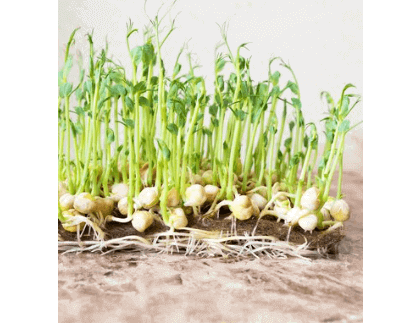
Hydroponic Garlic: What It Is and What Is Its Use?
Hydroponic garlic farming has emerged as an innovative method revolutionizing how we cultivate this beloved ingredient. The integration of hydroponics with garlic cultivation presents a groundbreaking approach that reshapes traditional farming practices.
Introduction
Hydroponics, a soilless farming technique, involves growing plants in nutrient-rich water solutions. Garlic, known for its culinary and medicinal significance, has found a new realm in hydroponic systems. Combining the benefits of hydroponics with garlic farming yields remarkable results, redefining how we grow this aromatic bulb.
Benefits of Hydroponic Garlic
- Enhanced Growth and Yield
- Hydroponic systems provide optimized conditions for garlic growth, leading to accelerated growth rates and increased yields.
- Studies have shown up to 25-30% faster growth rates compared to traditional soil-based cultivation methods.
- Controlled Environment Advantages
- Hydroponic setups offer precise control over environmental factors such as temperature, humidity, nutrient levels, creating ideal conditions for garlic growth.
- This controlled environment minimizes impact of external factors, leading to healthier plants and consistent yields.
- Reduced Dependency on Soil
- Hydroponic garlic cultivation eliminates need for fertile soil, making it viable in areas with poor soil quality or limited space.
- It reduces risk of soil-borne diseases and pests, contributing to healthier garlic crops.
- Water Efficiency
- Hydroponic systems use water more efficiently than traditional soil farming, with studies indicating a water usage reduction of up to 90%.
- Recycling and reusing water within closed-loop system minimize wastage, making it more sustainable method.
- Year-Round Cultivation
- Controlled environment in hydroponics allows for year-round garlic cultivation, irrespective of seasonal changes, ensuring continuous supply.
- Space Optimization
- Vertical or compact hydroponic setups enable efficient space utilization, making it suitable for urban areas or locations with limited land availability.
- It allows farmers to maximize production in smaller areas compared to traditional farming methods.
- Consistent Nutrient Supply
- Hydroponic systems deliver nutrients directly to plants’ roots, ensuring a consistent and balanced supply of essential nutrients.
- This leads to healthier plants and garlic bulbs with a higher nutritional content.
- Environmental Sustainability
- With minimal soil disturbance and reduced water usage, hydroponic garlic farming has a lower environmental impact, promoting sustainability.
- It minimizes need for chemical pesticides and fertilizers, contributing to a more eco-friendly farming approach.
- Commercial Viability
- Increased yield and faster growth rates can result in higher profitability for commercial growers.
- It offers opportunities for commercial-scale production in controlled environments, meeting market demands more efficiently.
Setting Up a Hydroponic Garlic System
Choosing the appropriate hydroponic system is crucial for successful garlic cultivation. Components such as nutrient solutions, containers, and lighting play pivotal roles. Establishing and maintaining the system requires careful attention to ensure optimal growth conditions for garlic.
Nutritional Value and Flavor
Hydroponically grown garlic boasts enhanced nutritional properties owing to the controlled nutrient solutions. This method influences the taste profile of garlic, often resulting in a more vibrant and potent flavor, appealing to culinary enthusiasts.
Comparison with Traditional Garlic Farming
Contrasting hydroponic garlic farming with traditional methods reveals significant differences. The controlled environment in hydroponics accelerates growth rates and ensures higher yields. Additionally, it minimizes the environmental impact compared to conventional soil-based farming.
Applications and Uses
- Culinary Uses
- Gourmet Cooking: Due to its robust flavor, it is highly sought after in gourmet cuisines.
- Commercial Food Production: Food industries use it in processed food products like sauces, condiments, and soups due to its consistent quality and taste.
- Medicinal Applications
- Health Supplements: Garlic, rich in medicinal properties like allicin, is used as a natural supplement. Its higher nutrient content is reason.
- Traditional Medicine: Garlic is valued for its potential to boost immunity, regulate blood pressure, and aid in various health conditions.
- Cosmetic and Beauty Industry
- Skin Care Products: Extracts from garlic are incorporated into skincare products due to their antioxidant and antibacterial properties, benefiting acne-prone or sensitive skin.
- Hair Care Solutions: Garlic’s potential to stimulate hair growth and strengthen hair strands makes it a component in some hair care formulations.
- Agricultural and Horticultural Use
- Natural Pesticide: Garlic’s natural insecticidal properties make it a valuable ingredient in organic pest control solutions for protecting other crops.
- Companion Planting: Planting hydroponic garlic alongside other crops can deter pests and improve the overall health of neighboring plants.
- Research and Development
- Genetic Studies: Hydroponic garlic serves as an excellent subject for genetic research due to its controlled growth conditions, aiding in study of plant traits and adaptations.
- Innovative Agriculture: Its use in controlled environments paves way for innovative agricultural techniques and technologies.
- Commercial and Industrial Purposes
- Pharmaceutical Industry: Garlic extracts are used in pharmaceutical sector for producing various medications.
- Biotechnological Applications: Garlic’s compounds find applications in biotechnological processes and research for their antimicrobial and antioxidant properties.
- Educational and Demonstration Purposes
- Learning Aid: Hydroponic garlic cultivation serves as an educational tool in schools and workshops, teaching about sustainable farming practices and plant biology.
- Demonstration Gardens: Exhibiting hydroponic garlic setups in botanical gardens or agricultural fairs showcases modern farming methods to public.
Challenges and Solutions in Hydroponic Garlic Farming
- Disease Management
- Challenge: Root rot, fungal diseases, and bacterial infections are common threats in hydroponic systems, impacting garlic health.
- Solution: Implement strict hygiene protocols, ensure proper ventilation, and use sterilized equipment to minimize disease spread. Additionally, employing beneficial microbes can aid in disease prevention.
- Nutrient Imbalance
- Challenge: Maintaining the right nutrient balance in the hydroponic solution is crucial for optimal garlic growth. Imbalances can lead to deficiencies or toxicity.
- Solution: Regularly monitor nutrient levels and pH, adjusting the solution accordingly. Using high-quality, balanced nutrient solutions formulated for garlic cultivation is essential.
- System Maintenance
- Challenge: Require regular upkeep, including cleaning, monitoring, and equipment maintenance, which can be labor-intensive.
- Solution: Implement a maintenance schedule for system cleaning, sensor calibration, and equipment checks. Automated systems or smart sensors can streamline monitoring processes.
- Environmental Control
- Challenge: Maintaining consistent environmental conditions (temperature, humidity, light) in indoor setups can be challenging, impacting garlic growth.
- Solution: Invest in climate control systems like HVAC (heating, ventilation, and air conditioning) and LED grow lights to regulate environmental factors. Employing climate sensors and automation helps maintain optimal conditions.
- Costs and Initial Investment
- Challenge: Involves initial investment in equipment, infrastructure, and quality inputs, posing financial challenges.
- Solution: Start small-scale to minimize initial costs and gradually expand. Research cost-effective equipment options and consider alternative funding or grants available for sustainable farming practices.
- Pest Infestation
- Challenge: Insects and pests can infiltrate hydroponic systems, affecting garlic plants and reducing yields.
- Solution: Implement preventive measures such as introducing beneficial insects, using physical barriers, and employing natural pest control methods to minimize infestations.
- Skill and Knowledge Requirement
- Challenge: Operating requires specialized knowledge and skills, which might pose challenge to new growers.
- Solution: Offer training programs, workshops, or online resources to educate growers on hydroponic techniques. Collaborate with experienced growers or seek mentorship to acquire necessary skills.
Future Prospects
The future of this farming looks promising. Ongoing innovations and technological advancements aim to further optimize growth conditions, increase yields, and make this method more accessible to farmers globally.
Conclusion
Hydroponic garlic farming represents a groundbreaking approach in the cultivation of this versatile ingredient. Its amalgamation of enhanced growth, nutritional value, and diverse applications signals a transformative shift in agricultural practices.
FAQs
- Is hydroponically grown garlic more nutritious than traditionally grown garlic?
- Hydroponic garlic tends to have enhanced nutritional value due to the controlled nutrient solutions used in its cultivation.
- Can hydroponic garlic be grown at home?
- Yes, hydroponic garlic systems can be set up at home with the right components and care.
- Does hydroponic garlic taste different from traditionally grown garlic?
- Hydroponic garlic often boasts a more vibrant and potent flavor compared to traditionally grown garlic.
- What are the main challenges of hydroponic garlic farming?
- Maintenance of the hydroponic system and disease management are among the key challenges faced in this method.
- What does the future hold for hydroponic garlic farming?
- Ongoing advancements aim to optimize growth conditions, increase yields, and make this method more accessible globally.
Visit our website for more. Click here: “Quick Trend Insights“.





